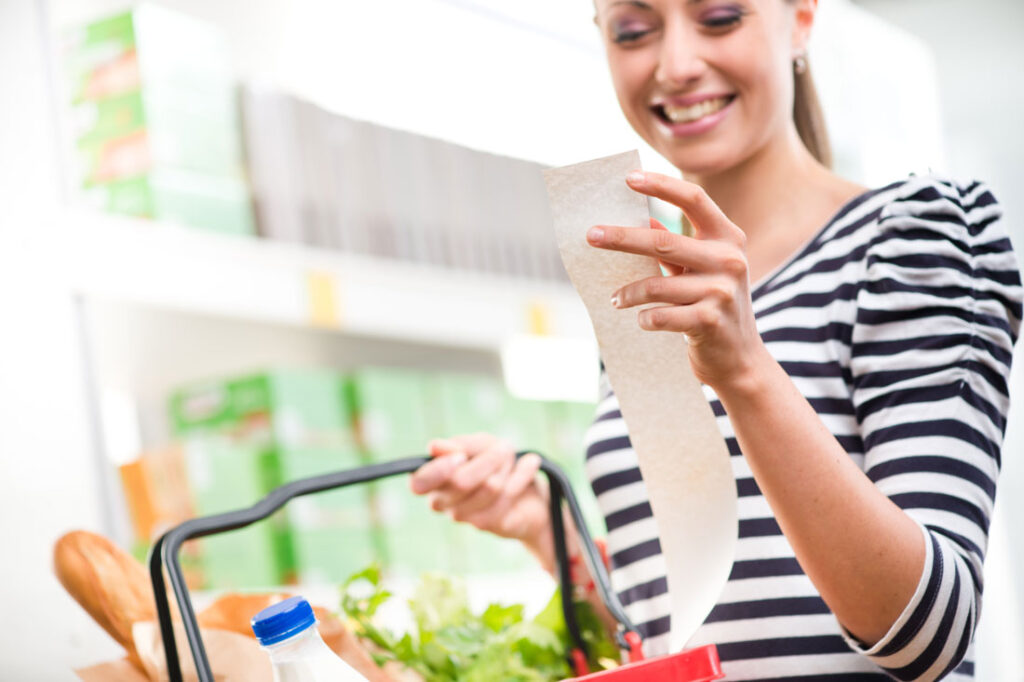Thanks to inflation, most of us are looking for ways to reduce our grocery spending. I have a family of five and in the last few years, my grocery budget has risen at least $200 a month. Of course, I’m not the only one feeling this change. Food prices in 2022 were 9.9% higher than the year before and are predicted to increase 2.3% more for 2024.
Most of us are feeling the effects of our budgets expanding. That’s why I spoke with experts to strategize tips and tricks for keeping our grocery spending in check. Here are 10 great suggestions.
1. Purchase seasonal produce
In-season produce is typically cheaper. Since it’s often local and more abundant, Avery Zenker, a registered dietician with Everflex Fitness, says stores offer better prices because they require fewer resources for transporting and storage. “In-season produce is recently picked, often at peak ripeness and peak nutrient content,” she says. “Nutritional value slowly degrades over time and with exposure to elements. This means you can get more nutritional bang for your buck.”
Hopefully, buying in-season produce will inspire you to cook more at home too—another money-saving tactic.
Hope Ware and her husband teach people practical frugality skills on their YouTube channel and website, Under the Median. Ware advises to pay attention to national sales cycles. Once crops ripen, farmers will sell their abundance at a discounted rate to grocery stores, who, in turn, pass those savings on to you.
Ware also tells me that sale prices are influenced by national holidays, so blueberries and strawberries go on sale for the Fourth of July, while cabbage and potatoes are cheapest around St. Patrick’s Day.
Tanya Peterson, VP of Brand at Achieve, a digital personal finance company, says you can save at least 15% and up to 75% off normal produce prices by purchasing what’s in season and on sale. “When working with a budget—which every household should be—this can make a sizable dent,” Peterson says.

2. Buy local
Buying seasonally is great; the only drawback is that some of the produce from far away may have been picked when it was under-ripe to make it to the grocery store in time. That’s why buying seasonally should ideally be paired with buying locally. Knowing when fruits and veggies in your area ripens will give you access to the best-tasting produce at the best price.
“We live in the Midwest, where summer squash is a prolific producer,” says Ware. “That means that every August, produce stands will offer zucchini at prices as low as 50 cents to $1.00 each.”
Supporting local agriculture also keeps money in the community, which leads to a more robust local food system, Zenker says. Kathy Gilchrist, a fractional CFO for several entrepreneurs, shares how she buys corn off the back of a farmer’s pickup truck. She frequents local organic berry farms too, where she can pick her own blueberries and raspberries from the bushes. This eliminates the extra cost of harvesting, transportation, and store markups.
Another way to cut out mark ups is to purchase a weekly produce basket from a local CSA (Community Supported Agriculture). They often offer me extra goods as a courtesy because we’ve established a friendship. It’s important to get to know your farmers. Ware says her favorite farmer sends her home with free samples of new produce he’s growing in exchange for an honest review. She’s even bartered for produce by working on his farm!
3. Strive for zero food waste
I’m guilty of having a messy fridge. It’s not something I’m proud of, and I’m working to improve my organization skills. I often find wasted food crammed in the back that we forgot about—a moldy piece of fruit, a half-eaten tub of hummus. Not only does this contribute to greenhouse gas emissions, but it hurts my pocketbook.
According to the United Nations Environment Programme’s Food Waste Index Report 2021, one-third of all food produced is wasted.
Imagine if you stopped wasting one-third of the food you purchased—it would save you money and be better for the planet. So how do we manage our food more efficiently? We learn the rules of better storage.
Did you know the middle shelves of your fridge have the coldest, most consistent temperature? This is where you should store dairy products that spoil easily, like eggs, cheese, and milk, while the crisper drawers should be reserved for fruits and vegetables. I highly recommend reviewing this fridge storage guide from Martha Stewart’s website.
4. Make a plan for using perishables and leftovers
One idea from Ware is to create a perishable food inventory, i.e., the items with the shortest shelf life go at the top and you use those in recipes first. I’ve done this before when I buy meat on sale, knowing it’ll spoil if I don’t use it within a day or two.
Frances Kellar, a recipe developer and food writer at Cooking with Our CSA says she reduces food waste by freezing vegetable scraps to make her own vegetable or bone broth later. I, too, keep a bag full of scraps in my freezer for this purpose, especially in the winter months when a hot bowl of broth is comforting.
For scraps you won’t reuse, consider putting them in a compost bin. If you don’t have space for one, many cities now offer a weekly pickup option so they can compost for you.
While I only add to my compost bin infrequently, I’m glad I have one because it’s turned our scraps back into rich fertilizer for our trees.
And of late, whenever I notice we aren’t going to finish something that week, like a block of Parmesan cheese or a loaf of bread, I stick it in the freezer for later, or share it with a neighbor. That way, the product will be used, not wasted.
5. Create a grocery price book
I keep a mental price list of a few staple grocery items. For instance, I know that my favorite milk brand is nearly a dollar cheaper at Whole Foods than at Sprouts. And Tillamook cheese is much more affordable at Costco than anywhere else.
But Ware suggests a more detailed approach: Keep a price book that compares the exact same items at competing stores. She does this for the top 15 items she regularly buys and updates it every quarter. “The advantage of a price book is you can instantly know whether an advertised price is a great deal,” she says.
6. Shop at locally owned ethnic grocers
My neighbor and I love the Indian market near our homes. The naan there is authentic—and affordable. We find so many interesting foods that would cost a lot more if we got them at a high-end grocery store.
Ware says that’s because small, locally owned ethnic food stores are a treasure trove of specialty ingredients. She says they often have the cheapest prices in town on organic produce too. You can score deals here you would never find anywhere else!
7. Buy in bulk and stock up at sales
It’s a good idea to shop at bulk warehouse stores when the items on your list are truly cheaper there. Just be careful you don’t fall into the trap of buying unnecessary things—warehouse spending adds up fast. I try to stick to my list and not veer from it.
Stock up on sale items, even if it costs you more up front. Using her price book, Ware says she identifies when an item falls below average and calls this the “buy price.” When it’s ultra-low, she stocks up.
Every summer, when strawberries are at their cheapest, I buy extra packages and freeze them for smoothies. It saves me considerable money over the frozen fruit packages I typically buy at Costco. You may also dehydrate and can produce too.
I find many grocery stores have a sale section in the back—it’s worth a meander. I’ve found organic peanut butter tubs for $1 a piece and deals on vitamins, snacks, and dinner staples, including pasta and beans. These can be stock-up items too.
8. Plant a garden and/or fruit trees
This might seem daunting if you don’t have a green thumb or lots of space, but it need not be. I suggest growing herbs at the very least. Kellar agrees your herb plot need not be “lavish or large”—a countertop herb garden is a fantastic start.
There you can grow thyme, rosemary, parsley, chives, cilantro, and even basil, near a window that receives direct sun. They’re always wonderful to cook with and you save money keeping them on hand.
Lindsey Chastain of Waddle and Cluck is a mother of six and a homesteader. She says you don’t need expensive raised beds or a greenhouse, just outdoor space or pots. She even grows vegetables in her front yard flower beds.
“Planting from seeds is the most economical way to get started with gardening,” she says. “Many libraries have seeds that can be checked out. They just ask that you bring some new seeds back after harvesting. Seeds can even be bought with EBT cards. You can grow vegetables on an apartment balcony, which is where I started vegetable gardening, or even indoors with plant lights if you are low on space.”
Another alternative I’ve found to maintaining a full-fledged garden is planting fruit trees. But this is an initial investment. Fruit trees and vines need well-draining soil, full sun, and lots of nutrients, Chastain says, and take a while to start producing.
My peach tree started producing in year two. Now every spring, I receive a good crop, which I can, freeze and bake with for months to come. If you are renting a home or have an outdoor area in an apartment, some smaller trees and vines can be potted and kept on the porch too.
9. Embrace Imperfection
You can find imperfect produce at farms, orchards, and farmer’s markets in specially marked bins, or even through online grocers such as Imperfect Foods. Peterson says to be on the lookout for “B” or “No. 2” produce, which means it doesn’t look perfect like “A” or “No. 1” produce, but is just as good.
In my city, I’ve found discount grocery stores have become more popular in recent years. They offer clearance food, which is about to expire or already expired, at a fraction of the price than regular retailers. (Many canned goods have a shelf life of up to five years, according to the USDA, well past the expiration date on the cans.) It’s a good idea to check your local area to see if there’s one by you. I promise you these places are like food oases for bargain hunters who don’t mind food a little past its prime.
10. Start small
It can be overwhelming to synthesize all of the advice presented here at once, so I suggest starting small with just one or two ideas. After speaking to so many experts, my main concern is the food waste in my house. I want to work on eliminating that first.
Where do you feel most compelled to start? Wherever it is, I hope the suggestions here inspire you to make lasting changes towards supporting your local food economy, preventing food waste, and saving some cash.
Photo by Stokkete/Shutterstock.com





